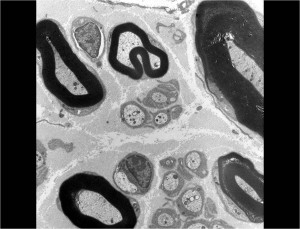Charcot-Marie-Tooth (CMT) disease is the most frequent form of inherited neuropathy. To date, more than 60 genes have been implicated in this heterogeneous group of neuropathies, and the recent advances in genetic technologies are promising. In this review, we discuss the diagnostic approaches and the underlying complex molecular processes. We also suggest a modification of the current classification, and we explain why such a change is needed. Actually, it seems very important to significantly simplify this classification, so that patients and their families, and Doctors can understand easily of which CMT sub-type they are speaking, which is difficult at the present time. (By Dr. Stéphane Mathis, http://jmg.bmj.com/content/early/2015/08/05/jmedgenet-2015-103272 )
Electron microscopy of a normal human sensory nerve, transverse section. The genes which are abnormal in the various CMT subtypes, encodes proteins of the nerve constituants. Some of them can be clearly seen at this magnification : M (myelin), MA (myelin axon), U (unmyelinated axon). C : collagen. Original magnification : x 2500.
